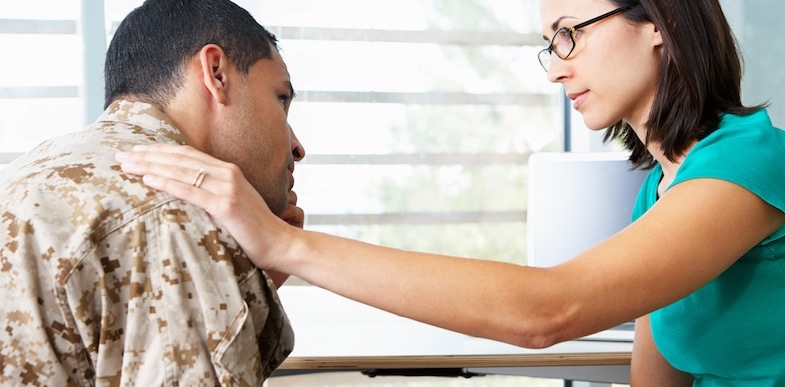
November 11 is Veterans Day, a federally-designated day to recognize all U.S. veterans who have served in both foreign and domestic settings. Far from being just another holiday when banks are closed and mail isn’t delivered, Veterans Day is set aside to recognize and honor the service and sacrifice of the millions of men and women who have served in the U.S. military from 1776 to today. Unfortunately, this group experiences particular challenges and high rates of chronic pain. We can and should do better.
How does chronic pain affect veterans?
Thousands of soldiers have been injured in the wars in Iraq and Afghanistan. Many of a soldier’s injuries may have been fatal in the past but are now treatable and require recovery times when soldiers return home. Wounded soldiers now have a survival rate of over 90% as compared to a survival rate of under 75% in the Vietnam War.
Other consequences can arise as a result of a near-fatal or life-changing injury, though, such as an amputation or head injury. Reports find that chronic pain and mental health challenges disproportionately affect veterans, including:
- According to statistics gathered by the Department of Veterans Affairs, more than 50% of those vets registered for healthcare have experienced chronic pain above a level four on a scale of one to ten. Back pain is the most common, followed by pain in the legs, arms, neck, and abdomen.
- Among an infantry brigade composed of 2,597 soldiers who were interviewed three months after returning home from Afghanistan, 44% experienced chronic pain. In this brigade, 15% reported using opioids in the past month.
- In the same study, published in the JAMA Internal Medicine journal, researchers reported civilian chronic pain rates at 26% of the population, with only 4% of that number using opioids.
- Other research indicates that approximately 30% of veterans returning from Iraq and Afghanistan suffer from mental health conditions. Additionally, fewer than 50% of the 730,000 estimated vets receiving mental health care.
- Twenty-two veterans die by suicide every day in the U.S. in 2012.
- Approximately 33% of homeless men are veterans, and veterans are twice as likely to become homeless when compared to civilian populations. The main factor in homelessness for veterans is inadequately treated physical conditions. This combines with mental and emotional conditions that can lead to alcohol or drug use.
Mental health challenges
Chronic pain is invisible enough, but the mental and emotional scars that veterans face are even more covert. Further, chronic pain and mental health challenges are inextricably linked with symptoms of one often exacerbating the other.
The stress of living in a combat situation followed by the stress of reintegrating into a society that doesn’t understand what it’s like to kill and destroy with the command to then forget leaves veterans at risk for depression and suicide.
Post-traumatic stress disorder (PTSD) in particular is a powerful mental condition that occurs as a result of experiencing major trauma. Veterans may suffer from flashbacks and anxiety attacks. Their body may react as if they were still in the middle of the trauma. This condition can be debilitating, yet many vets still attempt to handle it on their own. Civilians may not be able to understand why vets don’t seek the treatment that they need.
What are barriers to treatment?
Military personnel have barriers to treatment that are specific to their experience. Beyond general barriers such as race, class, and economics, military personnel tend to experience barriers that are specific to a military culture and ethos.
As many injuries sustained were in battle, there are a complicated mix of factors involved in treatment that may prove overwhelming to veterans seeking treatment.
Pride and embarrassment
Soldiers coming home from war with injuries, be they physical, mental, or emotional, may not be used to being unwell. From the heavy physical conditioning of basic training to action in battle, these men and women are generally young, physically fit, and ready for action.
They may not feel like they can ask for help when they need it and so may suffer in silence. This can lead to feelings of isolation and depression.
Veterans who struggle with addiction and mental illness may feel the stigma of those two conditions, especially if they are living in a small town.
Properly trained medical personnel
Because physical injuries are often further complicated by mental conditions such as PTSD and anxiety disorders, medical personnel need to be trained and educated on how to treat the entire soldier, not just the injury.
Veterans organizations can help, but their capacity is limited and the demand for care is high.
Availability of care
Especially in rural areas with few doctors and mental health providers for civilians, veterans may have a difficult time getting the care they need. Veteran care requires more than a general family doctor, with physical rehabilitation, mental health, and counseling for addiction as necessary parts of treatment.
Dr. Wayne Jonas, a commenter on the JAMA study, notes that it is crucial that we address issues of chronic pain and mental health in our veterans if we are to maintain a strong military:
“The nation’s defense rests on the comprehensive fitness of its service members—mind, body, and spirit. Chronic pain and use of opioids carry the risk of functional impairment of America’s fighting force.”
We would argue that addressing issues of chronic pain in our veterans is also a moral obligation to those who routinely sacrifice so much. They are the first responders of the U.S., the people who run towards the burning building. We owe it to veterans and their families to make sure that they are given the resources they need to heal completely and to continue to live full, rich lives either in or out of military service.

How you can help
Veterans need support in ways that many civilians cannot understand. Regardless, there are some things that you can do to show that you care.
- Offer understanding: You may not fully understand a vet’s experience, but you can listen and do your best. Encouraging veterans to talk about their time in combat can help with feelings of isolation.
- Lobby your politicians: Talk to your local representatives about fully-funding initiatives specifically designed to increase care for veterans.
- Don’t discriminate: Female veterans can be overlooked when it comes to services. New research is lobbying for better policies to help women adjust to civilian life after combat.
- Encourage the vets you know to reach out: There are several online forums designed for veterans. There you can reach out and communicate with others who understand. Some of these resources follow.
Resources available for veterans
1. Pets for Patriots
If you’ve ever had a cat or dog, chances are you know firsthand the blessing of unconditional love and devotion they bestow. When you’re having a rough day, there’s nothing better than seeing the loving eyes of your pet. At that moment, it seems like they would do anything in their power to make you feel better.
Pets for Patriots founders know the profound impact this relationship can have on people. They help connect veterans with dogs and cats living in shelters who need homes. Owning a pet can be expensive, but the organization partners with veterinarians to offer a lifetime discount on services to make health maintenance more affordable.
2. Wounded Warrior Project
This organization serves returning veterans through multiple programs designed to heal the mind, rehabilitate the body, find jobs, and stay connected with other veterans. The organization’s vision is to help this generation’s wounded veterans become the nation’s most well adjusted in history.
Programs include the Combat Stress Recovery Program, which helps participants set new goals and acclimate to their new normal. The project’s Restore Warriors program is geared towards helping veterans identify PTSD symptoms and then connecting them with professional help.
Veterans also struggle with finding employment after returning from war. Through Warriors To Work, the organization offers help creating a winning resume, refining interview skills, and connecting with hiring managers.
3. Veterans Yoga Project
Yoga and mindful breathing may help manage the symptoms of PTSD and chronic pain. Many non-profits have sprung up that seek to connect veterans to the practice of yoga.
Veterans Yoga Project offers a directory of classes taught by specially trained teachers. They also retreats for those looking to take a breath of fresh air.
4. Veterans Support Foundation
Returning soldiers unfortunately face high rates of homelessness. Veterans Support Foundation seeks to help those who need it find shelter, whether temporarily or permanently.
The organization offers transitional housing shelters in numerous states. Each state’s program is slightly different. In Connecticut, for instance, VSF runs three transitional living shelters. While living in the homes, veterans receive treatment and help to get their lives back on track. Permanent housing in Connecticut is also available. Programs vary by state, and are not offered in all states.
Check the website’s directory to learn about programs available in your state.
5. Veteran Crisis Line
By dialing 1-800-273-8255 and then pressing “1”, or texting 838255, veterans have immediate access to a crisis responder trained specifically to address veteran concerns. Callers are advised to press “1” to be connected to veteran-specific counselors. Otherwise, calls go to the National Suicide Prevention Lifeline, where a trained responder will offer assistance. An online chat is also available.
By recognizing the warning signs of suicide and reaching out for help early, more veterans’ lives can be saved. Danger signals include feelings of hopelessness, extreme anxiety or mood swings, rage, and increasing abuse of alcohol or drugs. After calling, the responder will help the caller connect to local counseling services.
6. National Resource Service Directory
Finding the right resource can feel overwhelming. If you’re not sure where to start, visit this directory, run by the Department of Veterans Affairs and the Department of Defense.
The directory makes finding resources for your specific need easy. Drop-down menus connect users to organizations offering support for finding employment, connecting with health services or homeless assistance, and collecting benefits and compensation.
7. USA Cares
If you need fast assistance, visit USA Cares. This organization helps veterans with financial help and advocacy, with the motto “a hand up, not a hand out.” The staff pledges to respond to all requests within 48 hours.
Main areas of assistance include housing and employment. Services are offered free to service men and women, and no repayment is required. If, for example, a veteran needs help paying the mortgage, USA Cares will make a payment directly to the bank.
Veterans serving overseas and in the U.S. provide tremendous service to the citizens of the United States. Make it a point to take the time to thank a veteran on November 11th (and every day) for their service.